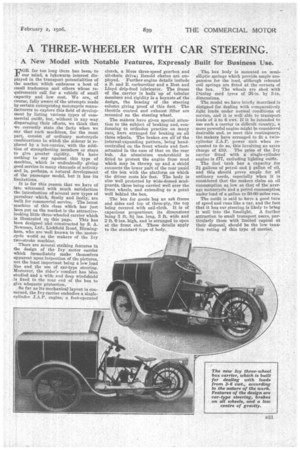A THREE-WHEELER WITH CAR STEERING.
Page 15

If you've noticed an error in this article please click here to report it so we can fix it.
A New Model with Notable Features, Expressly Built for Business Use.
FOR far too long there has been, to our mind, a lukewarm interest displayed in the transport potentialities of the market which embraces a host of small tradesmen and others whose requirements call for a vehicle of small capacity and low cost. We are, of course, fully aware of the attempts made by certain enterprising motorcycle manufacturers to explore this field of development by listing various types of commercial outfit, but, without in any way disparaging their efforts, we think that we correctly state the facts when we say that such machines, for the most part, consist of ordinary motorcycle combinations in which the sidecar is replaced by a box-carrier, with the addition of strengthening members or stays to give greater rigidity. We have nothing to say against this type of machine, 'which is undoubtedly giving good service in many channels of activity and is, perhaps, a natural development of the passenger model, but it has its limitations.
It is for this reason that we have of late witnessed with much satisfaction the introduction of several new types of parcelcar which, firstly and lastly, are built for commercial service. The latest machine of this class which has just been put on the market is the attractivelooking little three-wheeled carrier which is illustrated on this page. This has been designed arid constructed by S. A. Newman, Ltd., Lichfield Road, Birmingham, who are well known in the motorcycle world as the makers of the Ivy two-stroke machine.
There are several striking features in the design of the Ivy motor carrier which immediately make themselves apparent upon inspection of the pictures, not the least important being a low load line and the use of car-type steering. Moreover, the rider's 'comfort has ben studied and a wide and deep windshield is fixed to the rear end of the box to give adequate protection.
So far as its mechanical layout is concerned, the Ivy carrier embodies a singlecylinder :T.A.P. engine, a foot-operated clutch, a Moss three-speed gearbox and all-chain drive; Renold chains are employed. Further engine details include A. B. and B. carburetter and a Best and Lloyd drip-feed lubricator. The frame of the carrier is built up of tubular members and rigidity is a keynote 4:if the design, the bracing of the steering column giving proof of this fact. The throttle control and exhaust lifter are mounted on the steering wheel.
The makers have given special attention to the subject of braking and, conforming to orthodox practice on many cars, have arranged for braking on all three wheels. The brakes are all'of the internal-expanding pattern, being handcontrolled on the front wheels and footactuated in the ease of that on the rear hub. An aluminium undershield is fitted to protect the engine from mud which may be throwp up and a shield connects the lower part of the rear panel of the box with the platform on which the driver rests hisfeet. The body is also well protected by wide-domed mudguards, these being carried well over the front wheels, and extending to a point well behind the box.
The box for goods ha.4 an ash frame and sides and top of three-ply, the top being covered with sail-cloth. It is of capacious proportions, its dimensions being 3 ft. Si, ins. long, 3 ft. wide and 2 ft. 6 ins, high, and is arranged to open at the front end. These details apply to the standard type of body,
Tha box body is mounted on semielliptic springs which provide ample suspension for the load, although rebound coil springs are fitted at the corners of the box. The wheels are shod with Dunlop cord tyres of 26-in. by 3-in. dimensions.
The model we have briefly described is designed for dealing with comparatively light loads under normal conditions of service and it is well able to transportloads of 3 to 6 cwt. If it be intended to use such a carrier in difficult country, a more powerful engine might be considered desirable and. to meet this contingency, the makers have arranged to fit a twincylinder J.A,P, power unit when requested to do so, this involving an extra charge of £10. The price of the Ivy carrier fitted with a single-cylinder engine is £77, excluding lighting outfit.
The fuel tank has a capacity for 2/ gallons of petrol and gallon of oil, and this should prove ample for all ordinary needs, especially when it is considered that the makers claim an oil consumption as low as that of the average motorcycle and a petrol consumption under load of a gallon to 50-60 miles run.
The outfit is said to have a good turn of speed and runs like a car, and the fact that it has car steering is likely to bring it well into the limelight. A further attraction to small transport users, particularly those with limited capital at their disposal, should be the low taxation rating of this type of carrier.






























